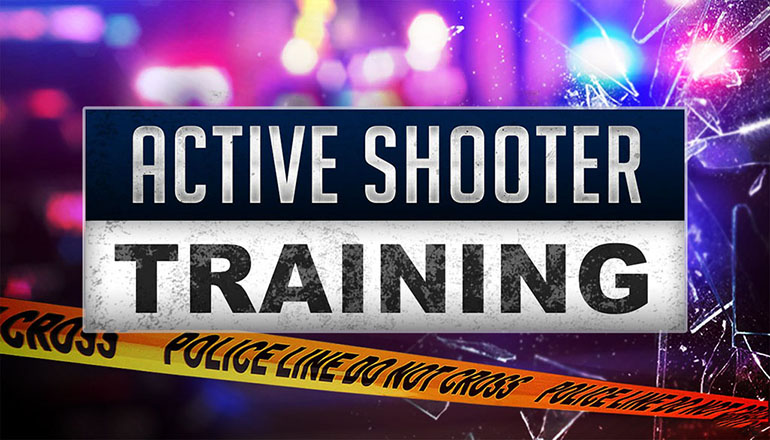How to Prepare Your Staff with Active Shooter Training for Emergencies
How to Prepare Your Staff with Active Shooter Training for Emergencies
Blog Article
Discovering the Secret Elements and Objectives of Reliable Active Shooter Training Programs
Energetic shooter training programs are critical in gearing up individuals and organizations with the needed abilities to react effectively to potential threats. As we explore the complexities of these training programs, it ends up being obvious that understanding their thorough nature is essential to boosting safety and security actions and feedback capacities.
Value of Energetic Shooter Training
Active shooter training programs are crucial for enhancing readiness and action when faced with potential threats. These programs intend to outfit people, organizations, and communities with the expertise and abilities required to efficiently react to energetic shooter circumstances. The enhancing frequency and extent of such occurrences underscore the importance of aggressive measures, as prompt and educated responses can substantially reduce harm.

In addition, these programs can help minimize the anxiousness and fear that commonly accompany discussions regarding possible threats. By giving organized guidance and sensible approaches, individuals obtain self-confidence in their ability to respond properly. Eventually, the importance of energetic shooter training exists in its potential to conserve lives, decrease injuries, and cultivate a ready and resistant area with the ability of encountering unforeseen challenges.
Key Parts of Training Programs
Efficient active shooter training programs normally integrate a number of key components made to prepare individuals for real-world scenarios. The very first element is extensive education on the nature of energetic shooter occurrences, including statistics, instance research studies, and mental factors that affect assailants. This theoretical structure is critical for promoting awareness and understanding amongst participants.
Next, programs often consist of training on personal precaution, highlighting the "Run, Hide, Fight" method. Participants find out exactly how to evaluate their environment, make fast decisions, and take appropriate activities during a situation. Additionally, the incorporation of efficient communication abilities is important, as individuals need to understand exactly how to report incidents and share crucial information with police.
Another crucial element is the participation of police or security experts, that offer understandings into tactical reactions and the importance of teamwork throughout a crisis. Programs must resolve the mental consequences of an active shooter circumstance, using strategies for coping and healing.
Finally, recurring training and correspondence course are vital to make certain that knowledge remains current and participants feel great in their capacities. With each other, these key components create an all-round training program that outfits people to react properly to an energetic shooter occasion.
Realistic Scenario Simulations
Realistic scenario simulations are a crucial element of active shooter training programs, giving participants with the opportunity to involve in hands-on technique that mirrors potential real-life scenarios. These simulations improve the this post training experience by developing an immersive setting where individuals can use academic understanding in functional settings.
Via using role-playing, mock circumstances, and specialized training facilities, individuals experience the prompt difficulties and stressors connected with an active shooter occurrence. This method of training promotes quick decision-making, teamwork, and the application of security procedures under stress. It permits -responders to develop essential abilities such as situational recognition, threat evaluation, and efficient emptying treatments.
In addition, realistic simulations next aid to recognize prospective weak points in participants' actions, allowing instructors to give targeted feedback and improve total readiness. The consolidation of varying circumstances, including different places and assaulter profiles, better enhances the training experience, guaranteeing that individuals are fully equipped to handle a variety of potential scenarios.
Ultimately, these simulations offer not only to advise but likewise to construct confidence amongst participants, promoting a sense of readiness that is essential for efficient emergency situation action despite an active shooter hazard. active shooter training.
Communication Methods in Training
Clear communication is crucial in energetic shooter training programs, as it directly affects the performance of reaction initiatives throughout a crisis. Training individuals have to understand the procedures and treatments that will direct their activities if encountered with an active shooter scenario. Establishing clear lines of communication makes sure that all people involved can communicate info without delay and accurately.

In addition, training programs must stress the significance of active listening. Inevitably, reliable interaction techniques are crucial for preparing people to react emphatically and cohesively in the face of an active shooter case.
Mental Readiness Techniques
Emotional preparedness methods are increasingly acknowledged as essential elements of energetic shooter training programs. These methods intend to equip individuals with the mental durability necessary to respond properly in high-stress situations. By promoting a state of mind in harmony with potential dangers, top article individuals can better manage worry, anxiousness, and confusion during important cases.
Key mental readiness approaches include scenario-based training and tension shot workouts. Scenario-based training submerses individuals in realistic simulations that resemble the chaos of an active shooter event, enabling them to exercise decision-making under stress. This direct exposure aids develop familiarity with emergency procedures, improving natural feedbacks.
Stress vaccination includes progressive exposure to stress-inducing circumstances, enabling individuals to establish coping systems. This can include breathing workouts, visualization methods, and cognitive restructuring to reframe unfavorable ideas. By integrating these methods, training programs can cultivate a sense of confidence and control, which is vital in crisis situations.
Moreover, post-incident psychological assistance is crucial to address the psychological consequences of an active shooter occasion. Including psychological health and wellness resources into training programs not just prepares people for instant reactions but additionally advertises long-lasting mental health, eventually adding to a safer and more resistant setting.
Final Thought

Report this page